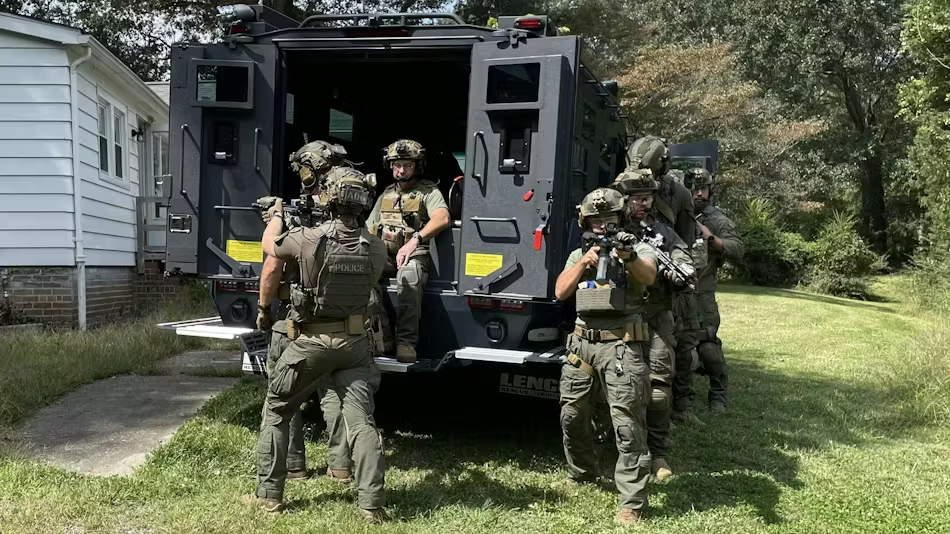Pasco County, Florida
Pasco County Fire Rescue hasn’t had nearly the history with tactical medics that the Green Fire Department has. The fire service agency in the county just north of Tampa initially set the wheels in motion for a group of tactical medics to work with the Pasco County Sheriff’s Office’s SWAT unit in early 2023. By December, the first members attended a mini-SWAT training school, and in February, Deputy Chief Shawn Whited received the first call in which tactical medics were needed.
“This was a high-risk search warrant that was going to be served at three in the morning, so we had prior acknowledgement of the SWAT call out,” Whited tells OFFICER. “For our first time going out and putting our paramedics in body armor and armored vehicles with their issued agency weapons and stuff, to be able to put them out in somewhat of a controlled call out was really reassuring.”
That first call ended up being the best kind of calls: uneventful. Medics weren’t needed, but deployment went smoothly. In fact, Whited was impressed with how seamlessly the agency’s medics meshed with the SWAT unit. Not only did the medics post at the SWAT unit’s command center and keep track of warrant execution via a live drone feed, but they also were brought in at the planning stage.
“Our guys that were with them were just like part of their team, like just integrated perfectly with them,” he says. “So to have that type of a first call out was really nice.”
The cooperation Whited saw on that first mission illustrates the “really great relationship” the fire agency and the sheriff’s office have, something that hasn’t always been the case. Although tactical medics are a recent addition, the two agencies had talks on and off over the years of creating the positions, but nothing could get hammered out until last year. The agencies’ increased closeness has bled through in other areas, too.
“They called us at the very onset and gave us a heads up and said, ‘Hey, we might have a barricaded subject, and he’s threatening to blow his house up, and he’s dumping gasoline all over his house, and he’s got propane tanks set up. … Can you send someone over to help in our planning cell?’” says Whited.
“They called us early, (and we) were able to get in there early,” he adds. “The sheriff’s office doesn’t know what the fire rescue capabilities are, and when you get a bunch of police officers in a room, they think up some crazy stuff. And one of their ideas was to attach a fire hose to the end of a battering ram and drive it through the wall of a house. I told them, that’s not a good idea. We’re not going to do that. So we came up with a different game plan that we have the expertise in, and they were like, ‘Oh, well, that actually makes more sense.’ And I’m like, ‘Right, you guys shoot the bad guys. We’ll put the fire out.’ … It’s really kind of united the two agencies to be on a better playing field.”
Like Ohio, Florida allows tactical medics to carry guns in self-defense, and it’s a privilege given to those in Pasco County. Whited says that officials did have initial talks about not arming tactical medics, but it was ultimately determined to allow them to carry guns to protect themselves. And just as important was making sure medics were legally protected, he adds.
“That was our biggest thing, we wanted to protect our members of the fire service, because ultimately, at the end of the day, they’re still they still work for the fire department. We wanted to make sure that they were well-protected. And like I said, through our agreement with the sheriff’s office and working with their attorneys and the county’s attorneys, we were able to come to a really good, solid understanding of how, God forbid, something should happen, whose responsibilities are where. And we’ve laid all that out, so we’re all on the same page.”
Currently, Pasco County has 16 tactical medics, but Whited says the goal is 22. When he thinks about the program’s future, Whited envisions more buy in and interest from those within the agency. That’s something he knows takes time, but now that the program is underway, he’s already seeing it grabbing the attention of a few of his colleagues.
“We had our first actual call out the other night, and since that call out, I’ve had three firefighter/paramedics that called me and said, ‘Hey, I didn’t know this was really going to happen.’ Well, we’ve sent out emails. It’s happening. We told you it’s happening. So now we have three more guys that are going to start going through the process.”


